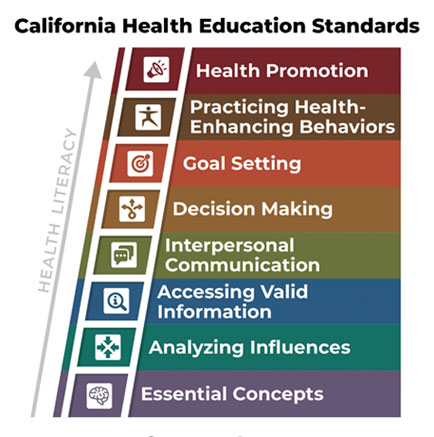
Middle Grade Health Education
SFUSD's middle grade health education classes are designed to support students with the knowledge and skills to be critical consumers of their own health and make health-enhancing decisions throughout their lives.
A Closer Look
What's Covered in Middle Grade Health Classes?

SFUSD's Health Education curriculum is designed to meet the guidelines of the California Health Education Standards, the California Health Framework, and related laws and policies like the California Healthy Youth Act.
Health Literacy Model
California students need to learn skills (i.e. the standards) to increase their Health Literacy , which has been defined by the World Health Organization as the cognitive and social skills which determine the motivation and ability of individuals to gain access to, understand, and use information in ways which promote and maintain good health.
Content
In middle grade health classes, we focus on six content areas:
- Nutrition and Physical Activity
- Growth, Development, and Sexual Health
- Alcohol, Tobacco, and Other Drugs
- Mental, Emotional, and Social Health
- Personal and Community Health
- Injury Prevention and Safety
Skills
In addition to teaching the about each of these topics, we are focusing on “skills-based health education,” where students actively practice real-life skills as a part of class. These are skills that we focus on:
- Analyzing Influences
- Accessing Valid Information
- Interpersonal Communication
- Decision Making
- Goal Setting
- Practicing Health- Enhancing Behaviors
- Health Promotion
More Details on Middle Grade Health Education
SFUSD offers two middle grade health education courses, designed to be taken in sequence. Courses will be implemented as trimester-length classes in both seventh and eighth grades.
Health 101
Students learn and practice the protective skills to make good choices and stay engaged in school despite the pitfalls of substance abuse, bullying, cyber-bullying, unhealthy foods, and peer pressure. They learn how their brain and body changes during their teen years, as well as how to care for and nurture them. Additionally, Puberty and Anatomy classes teach students about reproductive health, body development, positive body image, and healthy relationships while promoting values of diversity and inclusion.
Health 201
Students participate in deeper learning activities that shift the focus on health topics towards community and global health topics. Second year health students will also continue lessons on comprehensive relationship and sexuality curriculum so they have the skills and information they need to make healthy choices around pregnancy prevention, STIs, preventing sexual harassment and assault, and preventing Human Trafficking. Students review and practice healthy eating, goal setting, and how to counteract negative media messages about body image.
Policies and Requirements
Initiate Wonder: SFUSD's Middle Grade Redesign Initiative
SFUSD is rolling out redesign of its middle grade schools, called Initiate Wonder. The new schedule makes space for all students to take health education classes in 7th and 8th grade.
Want to Teach Health in SFUSD?
We need Health Education teaches in our middle and high schools!
To learn more about job openings in SFUSD, contact Teacher on Special Assignment Christopher Pepper at pepperc@sfusd.edu.
Curious about how to become a health teacher? Here's a great guide from CaliforniaHealthEducation.org.
Contact Us
To learn more about Health Education in SFUSD middle grade schools, contact Teacher on Special Assignment Christopher Pepper at pepperc@sfusd.edu.
This page was last updated on January 3, 2023

